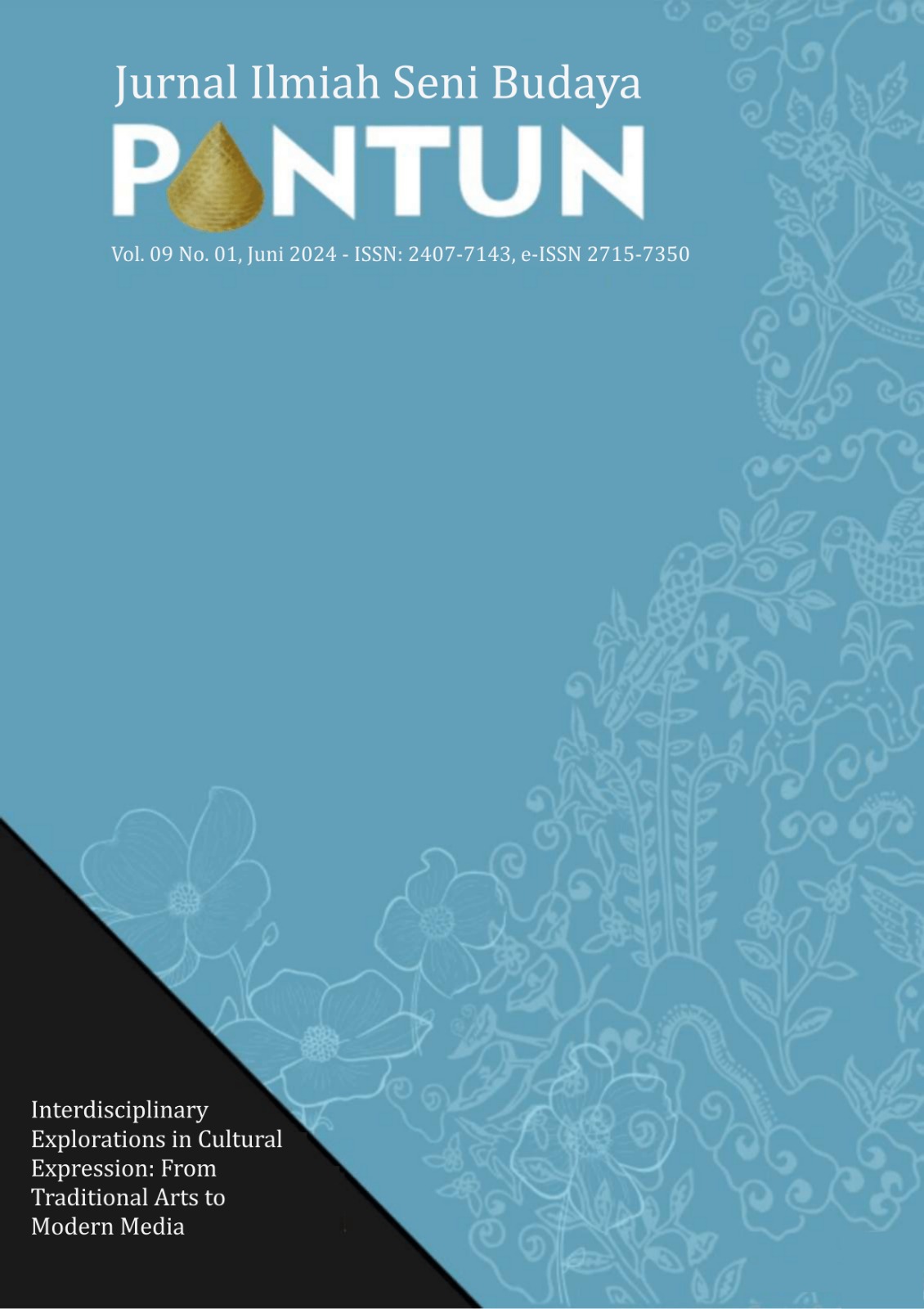The Influence of Visual Art in Irwan Jamal’s Theatre Artistic Vision
DOI:
https://doi.org/10.26742/pantun.v9i2.3604Kata Kunci:
Theatre; , visual art; , pointillism; , post-impressionism; , artistic vision; , symbolismAbstrak
Irwan Jamal, the founder of the Pictorial Theatre and the Casanova Theatre, is an artist who has studied several art disciplines at once, including theatre, visual arts, literature, and music. Genetic influences from his father’s family, who are skilled in drawing, as well as his education and experience in theatre, have resulted in a form of theatre that is rich in visual expression. This is based on Sigmund Freud’s theory of primary creativity which grows and becomes the foundation of one’s creativity. This article will also discuss and analysed the influence of the visual arts on Irwan Jamal’s vision of theatrical creations in terms of the several works he has directed, both theatrical productions as well as films and music videos. Irwan Jamal’s artistic vision and expression, which was later categorized as a form of “expressionist theatre” was very strongly influenced by the fine arts that Irwan Jamal also studied. The method used to analyse Irwan Jamal’s works (theatre and music videos) will also use the formal structure criticism method, which is usually used for the analysis of a painting. The presentation of critical works uses the method introduced by Edward S Feldman.
Referensi
Aroara, R., & Elgammal, A. (2012). 21st International Conference on Pattern Recognition (ICPR’12). In Towards Automated Classification of Fine-Art Painting Style: A Comparative Study. Japan. https://doi.org/doi:10.7282/T3XP73QP
Bungin, B. (2006). Metode Penelitian Kualitatif. Rajawali Pub.
Caroline, S. (2008). Cara Mengembangkan Berbagai Komponen Kecerdasan (Vol. 1). Yogyakarta.Indeks.
Elliott, A. (2000). Freud 2000. Melbourne: Melbourne University Press.
Feldman, E. S., & Barton, T. (2007). Tell me how you love the picture: A hollywood life. Beverly Hills: Creative Book Publishers International.
Jiao, S., & Zhu, X. (2022). Post-impressionism: Implicit salute towards its predecessors. Journal of Education, Humanities and Social Sciences, 1, 302–307. https://doi.org/10.54097/ehss.v1i.675
Jung, C. G. (2014). The undiscovered self. London: Routledge.
Kozik, P., Tateosian, L. G., Healey, C. G., & Enns, J. T. (2019). Impressionism-inspired data visualizations are both functional and liked. Psychology of Aesthetics, Creativity, and the Arts, 13(3), 266–276. https://doi.org/10.1037/aca0000175
Moloeng, Lexy J. 2007. Metode Penelitian Kualitatif. Bandung. PT. Remaja Rosdakarya.
Mukhina, M. V., Bagryanskaya, E. S., Bulganina, S. V., & Bulganina, A. E. (2021). Study of pointilism as a letter manner in the works of Field Signac. Design. Materials. Technology, (1), 108–112. doi:10.46418/1990-8997_2021_1(61)_108_112
Mukhina, M. V., Bagryanskaya, E. S., Chaikina, Zh. V., & Gureeva, E. P. (2021). Acquisition of creative composition writing by the method of pointilism. Design. Materials. Technology, (3), 42–46. doi:10.46418/1990-8997_2021_3(63)_42_46
Novák, R. (2020). Transmedia principles in impressionism spanning painting, music and literature. Neohelicon, 48(1), 299–312. 10.1007/s11059-020-00558-7
Nurhayati, R., & Santoso, A. (2018). Hubungan Antara Ekspresi Gambar Orang Dan Faktor-Faktor Kepribadian 16PF. Psikologika: Jurnal Pemikiran Dan Penelitian Psikologi, 23(2), 165–182. https://doi.org/10.20885/psikologika.vol23.iss2.art7
Männiste, K. (2021). Tension. Expressionist artistic style in stage design and original artworks of the first half of the 20th century. Baltic Journal of Art History, 21, 107–127. https://doi.org/10.12697/BJAH.2021.21.06
Radaeva, E. A. (2022). Cases of expressionism in modern dramaturgy and theater (on the example of plays by t. Letts, v. Sigarev). Izvestiya of the Samara Science Centre of the Russian Academy of Sciences. Social, Humanitarian, Medicobiological Sciences, 24(86), 91–99. https://doi.org/10.37313/2413-9645-2022-24-86-91-99
Rose, S. (2022). Post‐impressionism: Universal, British, global. Art History, 45(3), 546–569. https://doi.org/10.1111/1467-8365.12659
Saleh, B., Abe, K., & Elgammal, A. (2014). The Fifth International Conference on Computational Creativity (ICCC). In Knowledge Discovery of Artistic Influences: A Metric Learning Approach . Ljubljana, Slovenia.
Setiawan, A., Supriatna, S., & Wartika, E. (2023). Weaving emotions and culture: The success story of teh botol sosro’s packaging on Indonesia’s 75th Independence Day west java and DKI Jakarta edition. PANTUN: Jurnal Ilmiah Seni Budaya, 8(2), 87. https://doi.org/10.26742/pantun.v8i2.2714
Shinn, L. K., & O’Brien, M. (2008). Parent–child conversational styles in middle childhood: Gender and social class differences. Sex Roles, 59(1–2), 61–67. https://doi.org/10.1007/s11199-008-9443-1
Song, X. (2023). On Death of a Salesman from the Perspective of Cultural Genes Interpretation of “American Dream”. International Journal of Education and Humanities. ISSN: 2770-6702 | Vol. 9, No. 2, 2023. https://doi.org/10.54097/ijeh.v9i2.9887
Taufiq, M., Nalan, A. S., & Iskandar, A. (2023). Visual Identity Logo Collaboration Eiger 1989 X National Park Collection 2022. PANTUN: Jurnal Ilmiah Seni Budaya, 8(2), 139. https://doi.org/10.26742/pantun.v8i2.2722
Wang, B., & Afri, E. (2023). A case study of parent-child interaction in their reading activity. International Journal of English and Applied Linguistics (IJEAL), 3(2), 91–99. 10.47709/ijeal.v3i2.2372
Widiyatmaka, W., & Candra DA., NRA. (2016). Gaya Penyutradaraan impresionisme Pada film sang kiai. Capture : Jurnal Seni Media Rekam, 7(1). https://doi.org/10.33153/capture.v7i1.1569
Unduhan
Diterbitkan
Terbitan
Bagian
Citation Check
Lisensi
The Authors submitting a manuscript do so on the understanding that if accepted for publication, copyright of the article shall be assigned to Pantun: Jurnal Ilmiah Seni Budaya and Pascasarjana ISBI Bandung as the publisher of the journal. Copyright encompasses rights to reproduce and deliver the article in all form and media, including reprints, photographs, microfilms, and any other similar reproductions, as well as translations.
Pantun: Jurnal Ilmiah Seni Budaya and Pascasarjana ISBI Bandung and the Editors make every effort to ensure that no wrong or misleading data, opinions or statements be published in the journal. In any way, the contents of the articles and advertisements published in Pantun: Jurnal Ilmiah Seni Budaya are the sole and exclusive responsibility of their respective authors and advertisers.
The Copyright Transfer Form can be downloaded here: [……………..) The copyright form should be signed originally and send to the Editorial Office in the form of original mail, scanned document or fax :
Dr. Jaeni, S.Sn., M.Si. (Editor-in-Chief)
Editorial Office of Jurnal Pantun
Program Pascasarjana ISBI Bandung
Jl. Buah Batu 212 Bandung
Telp./fax +62-22-730532/+62-22-7303021
Email : jurnalpantun@isbi.ac.id









